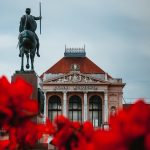April 18, 2023 – The Zagreb Museum of Arts and Crafts, which suffered an earthquake in 2020 and whose fund is currently unavailable to the public, is implementing a large exhibition project in cooperation with the Museum of Slavonia Osijek, in which the exhibition “MUO in Slavonia – Slavonia in MUO” will open at the end of April. The exhibition presents a selection of items from as many as fourteen collections of the Museum of Arts and Crafts.
It is an exhibition that will be open for one year at the Museum of Slavonia Osijek and which, for the first time in Croatia, will represent the most important art museum in Croatia in another city. The most representative objects from the collections of painting, printing and bookbinding, graphic design, older and newer photography, graphics, musical instruments, sculpture, ivory, clocks, textiles, metal, glass, ceramics and furniture will be exhibited, writes SiB.
The exhibition “MUO in Slavonia – Slavonia in MUO” is the crown of decades of close cooperation between the Museum of Slavonia and the Museum of Arts and Crafts from Zagreb. This large exhibition project was conceived as a presentation of the rich collections of MUO. Thanks to the exceptional fund of the Museum with a wide range of art, it was possible, in most cases, to connect it thematically with the area of Slavonia, so that the residents of Osijek, local and foreign tourists, will be able to enjoy the wealth of diverse and unique art presented for the next year.
Among the many valuable objects, some masterpieces from the Painting Collection will be exhibited, such as the paintings “Après” and “Portrait of Uncle Lac” by Miroslav Kraljević, the famous “Faust” by Izidor Kršnjavo from 1877, sketches by Bela Čikoš Sesija for making the curtains of the Osijek HNK from 1914, then the most representative figural clocks from the 18th and 19th centuries, such as a rare top performance clock with a built-in musical mechanism “Juno with Peacock Clock”, and fragments of Komersteiner’s set of the altar of St. King Ladislav from the old Zagreb Cathedral. From the collection of musical instruments in Osijek, a valuable violin of the famous Viennese violin maker Mathias Thier from 1787 will be exhibited, which is believed to have belonged to the young violin virtuoso and composer Franja Krežma, born in Osijek in 1862.
From the collection of textiles and fashion accessories, clothes and fashion accessories from the family wardrobe of Matilda Hengl, wife of the famous Osijek mayor Vjekoslav Hengl, who was a descendant of a prominent Osijek family of industrialists, owner of an Osijek leather factory, are particularly interesting for Osijek. The selection from the Metal Collection will be presented by a selection of profane objects of daily use from the 17th to the 19th century, such as baroque candlesticks, salt shakers, cutlery, jugs, candlesticks and others. No less significant exhibits for Slavonia come from the MUO Glass Collection. These are the products of two Slavonian glass factories from the 19th century: from the glass factory in Ivanovo Polje near Daruvar and the Zvečevo glass factory. Also, some of the most beautiful decorative and functional porcelain objects created in the Vienna Porcelain Manufactory and the Meissen Porcelain Manufactory will be exhibited from the Ceramics Collection, such as a dinner service or, for example, a porcelain figure of Empress Elizabeth, better known as Sisi. Out of a total of twenty exhibits in this part of the exhibition, five of them come from the collection of Jakob Frank from Osijek, a well-known publisher, journalist and collector. The furniture section will be presented as a history of furniture in stylistic-chronological sequence from the Renaissance to contemporary design using the example of chairs. The graphic design collection will present one of the oldest sports posters, “Tilden”, the work of the extremely productive studio Atelier Tri, which in the interwar period was professionally engaged in the field of economic propaganda. From the Photography Collection, the audience will be able to see the most famous reportage photographic works of Toša Dabac, Đura Janeković, Pav Urban and others. The exhibition will be enriched by exhibited rare manuscript books from the Collection of Printing and Bookbinding, which, according to their title, belong to the Capuchins in Osijek, Mathia Antun Relkovich’s volume Satir, Illiti Divji Csovik from the 18th century from the Osijek printing house Martin Divalda, and numerous other items. The collection of graphics at the exhibition is represented by valuable and rare cartographic works depicting the Slavonic area in the period from the 17th to the end of the 19th century, among which the work of the workshop of the famous German cartographer Johann Baptist Homann (1663 – 1724) stands out. Tabula geographica exhibens Regnum Sclavoniae cum Syrmii Ducatu (…) from 1745 with a description of the Kingdom of Slavonia and the Duchy of Sryjem.
In the impossibility of holding exhibitions in the main building of the Museum of Arts and Crafts, which is closed to the public for renovation, the intention is to maintain and spread awareness of its importance through guest exhibitions, and to enable other parts of Croatia to get acquainted with the enormous cultural and artistic wealth of the MUO’s collections. The Osijek exhibition is the central program of that project, which will also take place in the future in different variants in other museum institutions in the country, as well as in the wider region.
The author of the exhibition concept is Miroslav Gašparović, director of the Museum of Arts and Crafts. The curators of the exhibition are Ph.D. Marina Bagarić and Adriana Belay, and the authors of the exhibition sections and texts about the collections: Ph.D. Antonia Došen, Miroslav Gašparović, Dunja Nekić, Ph.D. Iva Prosoli, Koraljka Vlajo, Antonija Dejanović, Jasmina Fučkan, Ph.D. Vesna Lovrić Plantić, Andrea Klobučar, Ph.D. Arijana Koprčina, Ph.D. Marina Bagarić, Sandra Kandučar and Ph.D. Vanja Brdar Mustapić.
The exhibition was created in close cooperation with the team of the Museum of Slavonia headed by director Denis Detling and his associates, Grgur Marko Ivanković, Andreja Šimičić, Jesenko Ricl and others. The author of the exhibition is the well-known Osijek designer Vladimir Madunić.
For more, make sure to check out our dedicated Lifestyle section.









